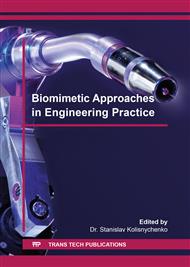[1]
LIN L M. Biomechanisms. Shanghai Jiao Tong University Press, 1991. 4.
Google Scholar
[2]
ZHANG X L, ZHENG H J, etal. Research on robotic bionics. Robot, 2002, 24 (2): 189-192.
Google Scholar
[3]
Stefan Czarnetzki, Sören Kerner, Oliver Urbann. Observer-based dynamic walking control for biped robots. Robotics and Autonomous Systems, 2009, 57: 839-845.
DOI: 10.1016/j.robot.2009.03.007
Google Scholar
[4]
Zhang W P, Hu T J, Chen J, Shen L C. BioDKM: Bio-inspired domain knowledge modeling method for humanoid delivery robots' planning. Expert Systems with Applications, 2012, 39: 663-672.
DOI: 10.1016/j.eswa.2011.07.058
Google Scholar
[5]
Klaassen B, Linnemann R, Spenneberg D, Kirchner F. Biomimetic walking robot SCORPION: Control and modeling Robotics and Autonomous Systems, 2002, 41: 69-76.
DOI: 10.1016/s0921-8890(02)00258-0
Google Scholar
[6]
Christophe Sabourin, Olivier Bruneau. Robustness of the dynamic walk of a biped robot subjected to disturbing external forces by using CMAC neural networks. Robotics and Autonomous Systems, 2005, 51(2): 81-99.
DOI: 10.1016/j.robot.2005.02.001
Google Scholar
[7]
Lewinger W A, Quinn R D. Neurobiologically-based control system for an adaptively walking hexapod. Industrial Robot An International Journal, 2011, 38: 258-263.
DOI: 10.1108/01439911111122752
Google Scholar
[8]
Mauricio Alba , Juan Carlos Garcia Prada, Jesus Meneses, etal. Center of percussion and gait design of biped robots. Mechanism and Mahine Theory, 2010 (45): 1681-1693.
DOI: 10.1016/j.mechmachtheory.2010.06.008
Google Scholar
[9]
Thanhtam Ho, Sunghac Choi, Sangyoon Lee. Development of a Biomimetic Quadruped Robot[J]. Journal of Bionic Engineering, 2009(4): 193-199.
DOI: 10.1109/robio.2009.4913123
Google Scholar
[10]
Kimura H, Fukuoka Y, Cohen A H. Adaptive dynamic walking of a quadruped robot on natural ground based on biological concepts. The International Journal of Robotics Research, 2007, 26, 475–490.
DOI: 10.1177/0278364907078089
Google Scholar
[11]
Fielding M R。Dunlop G R.Omnidirectional hexapod walking and efficient gaits using restrictedness. The International Journal of Robotics Research.2004, 23(10-11): 1105—1110.
DOI: 10.1177/0278364904047396
Google Scholar
[12]
Jie Chen, Yubin Liu, Jie Zhao, ect. Biomimetic Design and Optimal Swing of a Hexapod Robot Leg. Journal of Bionic Engineering, 2014 (11) 26–35.
DOI: 10.1016/s1672-6529(14)60017-2
Google Scholar
[13]
SUGAHARA Y, ARBONE G, HASHIMOTO K, et al. Experimental stiffness measurement of WL-16RⅡ biped walking vehicle during walking operation. Journal of Robotics and Mechatronics, 2007, 19(3): 272-280.
Google Scholar
[14]
WANG Hongbo, QI Zhengyan, HU Zhengwei, et al. Application of parallel leg mechanisms in quadruped/ biped reconfigurable walking robot. Chinese Journal of Mechanical Engineering, 2009, 45(8):024-032.
DOI: 10.3901/jme.2009.08.024
Google Scholar
[15]
Y. Lu, Y. Shi, B. Hu. Kinematic analysis of two novel 3UPU I and 3UPU II PKMs. Robotics and Autonomous Systems, 2008, 56(4): 296-305.
DOI: 10.1016/j.robot.2007.09.005
Google Scholar
[16]
Enrique Cuan-Urquizo, Ernesto Rodriguez-Leal. Kinematic analysis of the 3-CUP parallel mechanism. Robotics and Computer-Integrated Manufacturing, 2013, (29): 382–395.
DOI: 10.1016/j.rcim.2013.03.002
Google Scholar
[17]
Chen Zhang, LiyanZhang. Kinematics analysis and workspace investigation of a novel 2-DOF parallel manipulator applied in vehicle driving simulator. Robotics and Computer-Integrated Manufacturing, 2013 (29): 113–120.
DOI: 10.1016/j.rcim.2012.11.005
Google Scholar
[18]
Yi Lu , Bo Hu, Shi-Hua Li , etc. Kinematics/statics analysis of a novel 2SPS + PRRPR parallel manipulator. Mechanism and Machine Theory, 2008, 43: 1099–1111.
DOI: 10.1016/j.mechmachtheory.2007.10.002
Google Scholar
[19]
Stefan Dutr´e, Herman Bruyninckx, Joris De Schutter . The analytical Jacobian and its derivative for a parallel manipulator. IEEE International Conference on Robotics and Automation, Albuquerque, New Mexico, USA, 1997: 2961–2966.
DOI: 10.1109/robot.1997.606737
Google Scholar
[20]
Merlet J P. Jacobian, manipulability, condition number, and accuracy of parallel manipulators. Journal of Me-chanical Design, 2006, 128: 199-206.
DOI: 10.1115/1.2121740
Google Scholar
[21]
Gosselin C, Angeles J. A global performance index for the kinematic optimization of robotic manipulators. ASME Journal of Mechanical Design, 1991, 113: 220-226.
DOI: 10.1115/1.2912772
Google Scholar
[22]
G. Muscato, G. Spampinato. Kinematical model and control architecture for a human inspired five DOF robotic leg. Mechatronics, 2007, 17: 45-63.
DOI: 10.1016/j.mechatronics.2006.05.003
Google Scholar
[23]
X.J. Liu. Optimal kinematic design of a three translational DOF parallel manipulator. Robotica, 2006, 24: 239-250.
DOI: 10.1017/s0263574705002079
Google Scholar
[24]
Rong Yu, Jin Zhenlin, Qu Mengke. Statics analysis and optimal design of 3-DOF parallel mechanical leg. Transactions of the Chinese Society of Agriculture Engineeringm, 2012, 28(20): 41-49.
Google Scholar
[25]
Rong Yu, Jin Zhenlin, Cui Bingyan. Configuration analysis and structure parameter design of six-leg agricultural robot with parallel-leg mechanism. Transactions of the Chinese Society of Agriculture Engineeringm, 2012, 28(15): 9-14.
Google Scholar
[26]
Zhou Huijun, Gao Feng. Study progress of modern institutions. Beijing: higher education press, 2007: 253-298.
Google Scholar
[27]
Liu X-J,Wang J. A new methodology for optimal kinematic design of parallel mechanisms. Mechanism and Machine Theory, 2007, 42(9): 1210-1224.
DOI: 10.1016/j.mechmachtheory.2006.08.002
Google Scholar
[28]
Timotej Kodek, Marko Munih. An analysis of static and dynamic joint torques in elbow flexion-extension movements. Simulation Modeling Practice and Theory, 2002, 11: 297-211.
DOI: 10.1016/s1569-190x(03)00063-7
Google Scholar
[29]
Gao F., Zhang X. Q., Zhao Y. S., Wang H. R. A Physical Model of The Solution Space and the Atlases of the Reachable Workspace for 2-DOF Parallel Planar Manipulators. Mech. Mach. Theory, 1996, 31(2): 173-184.
DOI: 10.1016/0094-114x(95)00056-5
Google Scholar
[30]
Li Yanbiao, Jin Zhenlin. Design of a novel 3-DOF hybrid mechanical arm. Science in China, Series E, 2009, 52(4): 922-927.
Google Scholar



